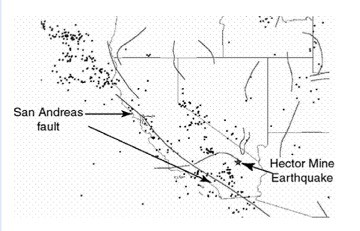Read the following exert from a USGS report concerning a recent earthquake and answer this question.Special Report: The Hector Mine Earthquake, 10/16/1999A M7.1 earthquake occurred at 2:46 a.m. local time on 10/16/1999.The event was located in a remote, sparsely-populated part of the Mojave Desert of California, approximately 47 miles east-southeast of Barstow and 32 miles north of Joshua Tree (see map next page). The initial magnitude estimate of 7.0 was upgraded to 7.1 on October 18, 1999, based on in-depth analysis of "teleseismic" data recorded worldwide.The earthquake occurred on the Lavic Lake fault, one of a series of north-northwest trending faults through the eastern Mojave shear zone. Geologists from the U.S. Geological Survey and Southern California Earthquake Center were able
to fly over the rupture (which is within the Twenty Nine Palms Marine Base) on the afternoon of October 16 and documented a 40-km long surface rupture. The aerial photos show an apparent maximum offset of 3.8-4.7 meters. These preliminary estimates for both fault length and slip are consistent with expectations for a magnitude 7.0 earthquake, although the slip is perhaps somewhat larger than average. The fault is one of a series of closely spaced, northwest-trending, right-lateral strike slip faults that traverse this portion of the Mojave Desert. Together, these faults within what is termed the Mojave Shear Zone serve to relieve a small portion of the stresses that build up along the boundary between the Pacific and North American tectonic plates.An interesting aspect of the Hector Mine earthquake is that it occurred only 7 years after the 1992 Landers and Joshua Tree earthquakes, which occurred on similar faults within the Mojave Shear Zone. This apparent clustering of earthquakes may be purely coincidental, but scientists are conducting research to see if this kind of earthquake behavior is typical of this region. That is, perhaps many of the Mojave Shear Zone faults produce earthquakes within a short time interval (perhaps spanning several hundred or more years), followed by several thousands of years of quiescence.  What is the current hypothesis scientists are investigating with regard to this fault system?
What is the current hypothesis scientists are investigating with regard to this fault system?
A. This is a region of quiescence.
B. Strike-slip faults in the Mojave Shear Zone relieve stress along the North American and Pacific plates.
C. Earthquakes in this region occur in clusters.
D. Earthquake magnitudes determined from fault-slip and teleseismic observations are similar.
Answer: C
You might also like to view...
Most coal has the same sulfur content, but varies widely in heat content
Indicate whether the statement is true or false
Use a rough map sketch to help explain the role that the oceans play in determining the climates of southern South America and Southern Africa, poleward 20oS
What will be an ideal response?
Which of the following best matches the description?Portion of the population growth curve that shows the population declining.
A. population density B. lag phase C. death phase D. emigration E. exponential growth phase F. carrying capacity G. stable equilibrium phase H. age distribution I. density-independent factor J. density-dependent limiting factor K. r-strategist L. dispersal M. biotic potential N. K-strategist O. environmental resistance P. immigration
Compounds known as a-hydroxycarboxylic acids are found in many cosmetics. These compounds contain both a hydroxyl group and a carboxyl group. What is the minimum number of oxygen atoms present in an a-hydroxycarboxylic acid?
A) 1 B) 2 C) 3 D) 4